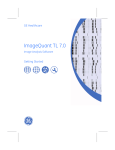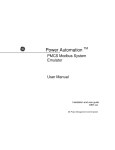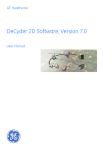Download Addendum to DeCyder 2D™ 7.0 User Manual, 28-9414
Transcript
Addendum to DeCyder 2D™ 7.0 User Manual, 28-9414-47 AA Introduction DeCyder 2D version 7.1 is an upgrade from 7.0 with a new functionality to normalize abundance values using spike proteins. This is a complement to the present model based normalization. It is suitable for experiments where one or several proteins have the same presence in all samples and can be used as references for the normalization. The spike normalization is added in the DIA and the BVA modules. Spike Normalization Limitations of model based spot normalization The model based spot normalization in DeCyder 2D DIA and BVA is based on the assumption that the majority of all proteins in a gel keep their expression level between the different samples in an experiment. In a classic DIGE experiment it is important that at least 100 spots, preferably 2000-3000 spots, are detected to get a valid normalization. However, this approach is not optimal for applications with samples that have few protein spots or samples where the majority of the proteins differ in expression level between samples. Summary and benefits of spike normalization To expand the usability of the software, an alternative normalization tool based on so called spiked proteins is introduced in DeCyder 2D 7.1. With this it is possible to normalize the proteins in an experiment to user selected proteins in the samples. Spike proteins must be added to the samples prior to the CyDye labelling step. It is important to select spike proteins with a minimum of interference/overlay with any protein spots in the sample 2D map. They should also be of other origin/species than the sample proteins to avoid interference with the differential analysis or protein identification errors. So called housekeeping proteins of the sample itself (proteins known to be of constant concentration in all samples) can also be used for the spike normalization procedure. A typical application where the spike normalization is applicable is for the accurate determination of host cell proteins (HCP) in the downstream purification process for biopharmaceutical products. 1 Addendum to DeCyder 2D™ 7.0 User Manual, 28-9414-47 AA Spike Normalization Detailed description of spike normalization Spike normalization is an alternative to the model based normalization. It still normalizes volume ratios but based on a few spike proteins and not the complete set of proteins in a whole workspace. The model based normalization is described in Appendix B.2 "Detailed description of spot normalization procedure" in DeCyder 2D 7.0 User Manual. Spike normalization in DIA module In the DIA module, spike normalization will adjust the volume ratio so the mean volume ratio for all spike proteins will be the 1.0 volume ratio. The spike volume ratio is calculated as follows: Ri = (V1i/V2i) / Rspike Where Ri is the spiked volume ratio for the i:th protein V1i is the spot volume in one sample for the i:th protein V2i is the spot volume in the other sample for the i:th protein Rspike is the raw mean volume ratio for all spike proteins Spike normalization in BVA module In the BVA module, spike normalization will normalize the standard abundance value for all proteins so the mean value of all spike proteins standard abundance will be set to 1.0. The spike standard abundance is calculated as follows: Si = (Vix/Vixs) / Sspike Where Si is the spiked standard abundance for the i:th protein Vix is the spot volume for the i:th protein and the x:th spot map Vixs is the spot volume for the standard spot corresponding to the i:th protein and the x:th spot map Sspike is the mean standard volume ratio for all spike proteins 2 Addendum to DeCyder 2D User Manual 28-9680-43 AA Addendum to DeCyder 2D™ 7.0 User Manual, 28-9414-47 AA Details of new features in DIA module Details of new features in DIA module In the DIA Main window, there are two visible changes in version 7.1: • in the Spot Control Panel there is a new checkbox, Spike. • in the table view there is a new column, Spike. The word Spike in the new column indicates that the protein is assigned as a spike protein. When spike normalization will be used in the BVA module, perform all normalization in the BVA module. Spike normalization performed in the DIA module will not be included when importing the workspace into the BVA module. How to use spike normalization in DIA 1 Tip: Identify the spiked protein(s) using the gel view. Select the spike proteins one by one and tick the Spike checkbox to indicate that this is a spiked protein. Use the comment field for the spiked protein name to have better control and be able to vary the assigned spiked proteins. 28-9680-43 AA Addendum to DeCyder 2D User Manual 3 Addendum to DeCyder 2D™ 7.0 User Manual, 28-9414-47 AA Details of new features in DIA module 2 When all spiked proteins are assigned, click on the Process menu and select Normalize on Spiked Proteins to perform the spike normalization. 3 Verify the normalization by viewing the volume ratios for the spiked proteins one by one. They should all have volume ratios close to 1.0 or -1.0. This is also shown in the histogram scatter plot but the values are close to 0.0 ( = log(1.0)). If a single spike protein is used the volume ratio is 1.0 and the protein is placed on 0.0 in the histogram scatter plot. The result of the normalization is displayed in the Histogram View, with histograms showing the volume ratios. If there is only one spike protein, it will be in the middle of the graph at point 0.0 (i.e. log(1.0) ). Compared to the model based normalization the pattern in the graph will remain exactly the same but shifted to its spike normalized values. Figure 1. The histogram graph for a spike protein when normalized with model based normalization (left) and spike normalization (right). Note that the plot of volume ratios has the same pattern for both types of normalization but is shifted to the right for the spike normalization. Note: The menu item Process->Re-normalize is the same as before and will force a recalculation of the selected normalization. Normally this is done automatically when changing the spike assignments but not when changing excluded spots. 4 Addendum to DeCyder 2D User Manual 28-9680-43 AA Addendum to DeCyder 2D™ 7.0 User Manual, 28-9414-47 AA Details of new features in BVA module Details of new features in BVA module In the BVA Main window, there are two visible changes in version 7.1: • In the Data View Control Panel there is a new checkbox, Spike. • In the Protein table there is a new column, Spike. The word Spike in the new column indicates that the protein is assigned as a spike protein. When spike normalization will be used in the BVA module, perform all normalization in the BVA module. Spike normalization performed in the DIA module will not be included when importing the workspace into the BVA module. How to use spike normalization in BVA 1 Identify the spiked protein(s) using the gel view in P (Protein Mode). Check the appearance number for all spiked proteins. For a good normalization all spiked proteins should be present in all spot maps. If a spike protein is mis-matched or missing in a spot map, go to M (Match Mode). Use the spot editing options in the Data View Controls to correct the matching until all spike proteins are present and matched in all spot maps. (See 5.9.2 Available editing options in DeCyder 2D User Manual.) 28-9680-43 AA Addendum to DeCyder 2D User Manual 5 Addendum to DeCyder 2D™ 7.0 User Manual, 28-9414-47 AA Details of new features in BVA module 2 Tip: Go to P and select the spiked proteins one by one and tick the Spike checkbox to indicate that it is a spiked protein. Use the comment field for the spiked protein name to have better control and be able to vary the assigned spiked proteins. 3 When all spiked proteins are assigned, click on the Process menu and select Normalize on Spiked Proteins, to perform the spike normalization. 4 Verify the normalization by viewing the standard corrected abundance for the spiked proteins, one by one. They should all have volume ratios close to 1.0 or -1.0. This is also shown in the graph, the values should be close to 0.0 ( = log(1.0) ). The line between the experimental groups is close to horizontal for all spiked proteins. If a single spiked protein is used the volume ratio is 1.0 and the line is horizontal. Figure 2. The graph for a spike protein when normalized with model based normalization (left) and spike normalization (right). All spike proteins should have a graph between their experimental groups close to the 0.0 point (i.e. log(1.0) ). 6 Addendum to DeCyder 2D User Manual 28-9680-43 AA Addendum to DeCyder 2D™ 7.0 User Manual, 28-9414-47 AA Installation of DeCyder 2D version 7.1 Installation of DeCyder 2D version 7.1 The installation guide can be found in the DeCyder installation via the start menu. The procedure for upgrading is a bit different depending on whether DeCyder 2D 6.5 or 7.0 is already installed: • If DeCyder 2D 6.5 is installed: Backup the DeCyder database and then uninstall the complete software package (see Section 5 "Uninstallation" in the "DeCyderInstallationGuide.pdf") before installing. • If DeCyder 2D 7.0 is installed: Backup the DeCyder database and then uninstall the database and the program part (see Section 5 "Uninstallation" in the "DeCyderInstallationGuide.pdf") before installing. The Oracle Server can remain installed. Licensing Access to the spike normalization is controlled by the eLicense system. For details on eLicensing, see Section 4, “eLicense installation and activation", in the "DeCyderInstallationGuide.pdf". The installation guide can be found in the DeCyder installation via the start menu. 28-9680-43 AA Addendum to DeCyder 2D User Manual 7 For local office contact information, visit www.gelifesciences.com/contact GE, imagination at work and GE monogram are trademarks of General Electric Company. GE Healthcare Bio-Sciences AB Björkgatan 30 751 84 Uppsala Sweden DeCyder includes an Oracle® 10g database. Copyright © 1995 – 2007 Oracle Corporation. All rights reserved. www.gelifesciences.com/decyder This product includes parts developed using ITK, Copyright © 1999-2003 Insight Software Consortium, for licensing information see, http://www.itk.org CyDye and DeCyder are trademarks of GE Healthcare companies. All third party trademarks are the property of their respective owners. Third Party Credit statements: Oracle is a registered trademark of Oracle Corporation and/or its affiliates. This product includes the Xerces XML parser. Copyright © 2000 The Apache Software Foundation, http://www.apache.org . All rights reserved. Parts of this product implement the libTiff library, Copyright © 1988-1997 Sam Leffler, Copyright © 1991-1997 Silicon Graphics, Inc, http://www.libtiff.org Parts of this product include NMath components from CenterSpace Software LLC, Copyright © 2002-2008. All rights reserved. http://www.centerspace.net Parts of this product include components from Farpoint Technologies, Inc. Copyright © 1991-2007. All rights reserved. http://www.fpoint.com Parts of this product include the TeeChart component from Steema Software SL. Copyright © 1995-2008. All rights reserved. http://www.teechart.com Parts of this product include the open source MD5 implementation by L. Deutsch. Copyright © 1999, 2000, 2002 Aladdin Enterprises. All rights reserved. Parts of this product include Cool Scrollbar Library. Copyright © 2001 J. Brown. CyDye: 2-D Fluorescence Difference Gel Electrophoresis (2-D DIGE) technology is covered by US patent numbers US6,043,025, US6,048,982, US6,127,134, and US6,426,190 and foreign equivalents and exclusively licensed from Carnegie Mellon University. CyDye: This product or portions thereof is manufactured under license from Carnegie Mellon University under US patent number US5,268,846 and other patents pending. The purchase of CyDye fluors includes a limited license to use the CyDye fluors for internal research and development, but not for any commercial purposes. A license to use the CyDye fluors for commercial purposes is subject to a separate license agreement with GE Healthcare. © 2010 General Electric Company – All rights reserved. First published Jan. 2010 All goods and services are sold subject to the terms and conditions of sale of the company within GE Healthcare which supplies them. A copy of these terms and conditions is available on request. Contact your local GE Healthcare representative for the most current information. GE Healthcare Europe GmbH Munzinger Strasse 5, D-79111 Freiburg, Germany GE Healthcare UK Limited Amersham Place, Little Chalfont, Buckinghamshire, HP7 9NA, UK GE Healthcare Bio-Sciences Corp. 800 Centennial Avenue, P.O. Box 1327, Piscataway, NJ 08855-1327, USA GE Healthcare Japan Corporation Sanken Bldg.3-25-1, Hyakunincho Shinjuku-ku, Tokyo 169-0073, Japan imagination at work 28-9680-43 AA 01/2010


















